Coq Au Vin, with Real Coq
11 Mar 2016A little while ago I made a traditional French Coq au Vin, or at least as traditional as I could find from browsing old cookbooks and spending some time with my friend The Google.
The History
Coq au Vin is a French dish that is, most simply, a chicken stew in red wine sauce. It’s a very old recipe that supposedly dates all the way back to roman times, although the only written examples seem to be from the 1900s on. When I started my research I found dozens if not hundreds of variations on the recipe. Some had aromatic vegetables, some had onions and mushrooms, some had brandy or cognac, some had the chicken cooked in the sauce, and some had the chicken and the sauce cooked separately and then served together.
The one key thing that is generally understood about traditional Coq au Vin, however, was that it was supposed to be made with a farmyard rooster (hence the “coq” (cock) – and not “poulet” (chicken)). In Ye Olden Tymes if you kept chickens, a batch of new baby chicks hatched in the springtime. Assuming the normal chromosomal distribution in that batch you would get half hens and half roosters. But a small flock of chickens does not need more than one rooster — in fact, more than one is generally a bad thing because they fight — so after raising up the roosters over the summer, in the fall and winter you would kill them and eat them.
The meat of older chickens, be they 6-month-old roosters or even older laying hens, is super tough. All the moving around in that time doing important chicken things (chicken staff meetings, chicken progress reports, chicken analytics, chicken sprint review) means that their muscles are denser and the connective tissue is hard and stringy. The chickens we buy in parts in the supermarket today are no more than a couple months old, and they don’t move much in their short lives. That’s why they are so tender. They are still babies.
The traditional coq au vin recipe involves braising a rooster in wine and stock for a really long time to break down the tough meat and connective tissue and to soften it up. That long braising time is how you actually make an old rooster edible. The long braising time also reduces and enriches the wine sauce. The long time to cook is part of the entire point.
Modern coq au vin recipes have been adapted to the new modern chickens, given that it is essentially impossible to buy old roosters or hens. But modern supermarket chickens only need half an hour or less to cook. Any more and you end up, ironically, with dry and tough chicken. Half an hour cooking time gets the food on the table, but isn’t really enough time for the wine sauce to really come into it’s own, flavor-wise. Modern Coq Au Vin recipes may be chicken stew in wine sauce, but are they really Coq au Vin?
If I wanted to make a truly traditional Coq Au Vin, I would need a farmyard rooster.
The Prime Ingredient
As it happens, I had a farmyard rooster.
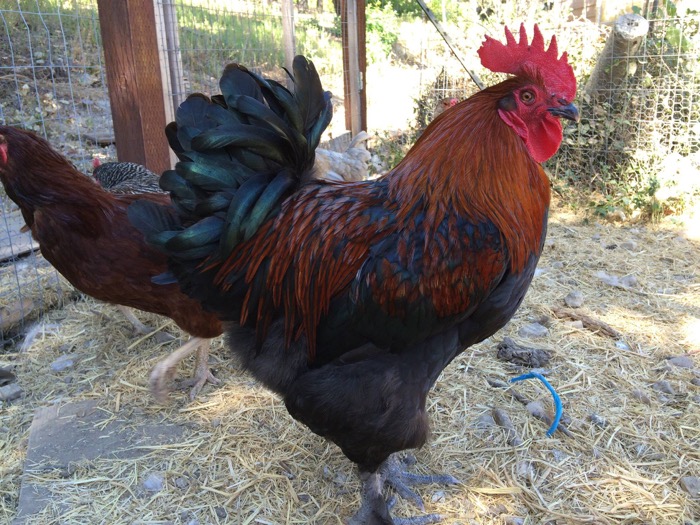
This is my #2 rooster, from some Marans eggs I hatched last year. There were actually four roosters, and two of them went into the freezer when they were much younger. I didn’t whack the #2 rooster because he was pretty and because for the most part he got along with the #1 rooster and with the hens. Mostly I put it off because I just don’t like doing it.
But then a month or so ago he started to get much more aggressive. He got into many more regular spats with rooster #1, and a few weeks ago he came up behind me when I wasn’t watching him and kicked me really hard. All of these were signs that it was time. No one loves an extra rooster, and a mean extra rooster is the worst of all.
Fade to black. #2 Rooster is no more. #2 Rooster has ceased to be. #2 is bereft of life, he has shuffled off this mortal coil, he has joined the choir invisible. #2 is an ex-rooster.
The Prime Ingredient, Later On
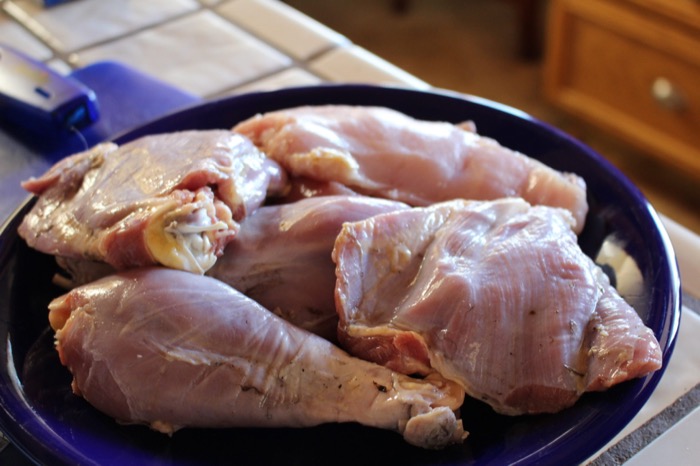
This is what the meat of an older chicken looks like, after it has been cleaned and pieced. There is no skin on these parts because plucking the feathers off of a chicken takes forever, and you don’t really need the skin for the stews and braises that older chicken needs. It’s easier and faster to just skin the bird and be done.
The connective tissue around the meat is notably thicker here than on a young chicken. Note also that the thighs and legs are really dark and really red, much more so than a supermarket chicken. This is both because the age of the chicken as well as the breed — supermarket meat chickens are bred to be lighter in color and milder in taste in all parts because generally people like white meat much more than they do dark.
The little black bits you see here and there are feathers, some of them quite thin and hair-like. I remove most of the feathers with the skin, but it’s hard to get rid of them all. They look kind of ugly, but they don’t harm anything. These tiny hairs are on supermarket meat chickens, too, but usually you can’t see them because meat chickens are white.
Compiling the Recipes
Initially I figured I could just use Julia Child’s recipe for Coq au Vin in Mastering the Art of French Cooking and be done with it. You can’t really go wrong with Julia. I was somewhat dismayed to discover that in my copy of Mastering, even Julia’s recipe calls for a normal young meat chicken, and cooks it for only 30 minutes.
With some more time spent on Google I determined that other than variations on vegetables, herbs, and other ingredients, the core of the recipe for Coq au Vin was mostly the same between the older and newer recipes – the only big difference being the time the chicken spent cooking in the red wine sauce.
My plan, therefore, was to actually stick with Julia’s recipe in terms of the ingredients and proportions, but go with a longer cooking time. Easy peasy.
Building the Stew
Coq au Vin is all about the chicken, but it also always includes a cured pork product. Traditionally this is lardons, which is just lightly salt-cured pork fat. I was all out of pork fat. (if you had asked me last year, I would have had some, but I made lard out of it.)
Second choice for the pork was bacon, but I was worried that the strong bacon flavor would overpower the dish (not all bacon is good all the time). I settled on pancetta, which is cured but not smoked pork belly. Pancetta is a lovely thing.
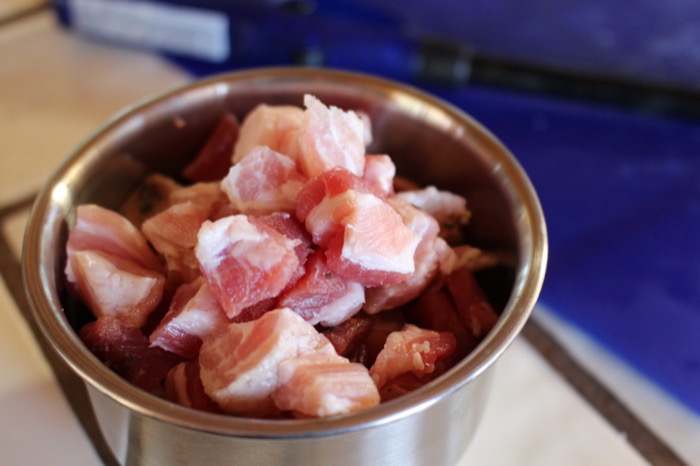
I fried up the pancetta with a big knob of butter in a nice big pan until it was nice and browned.
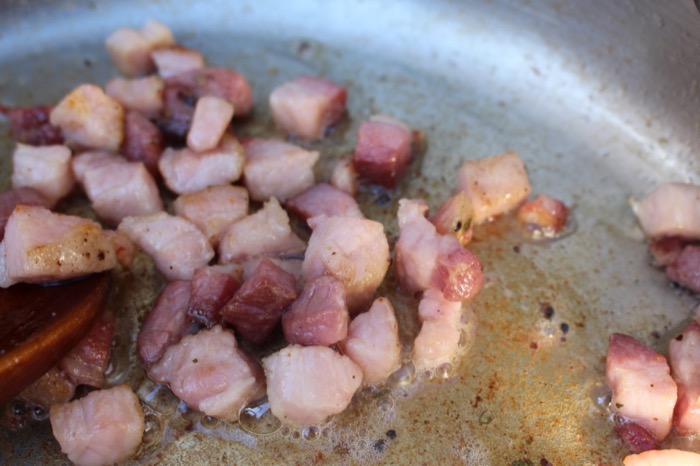
Then I removed the pancetta and added the chicken pieces, browning them on all sides.
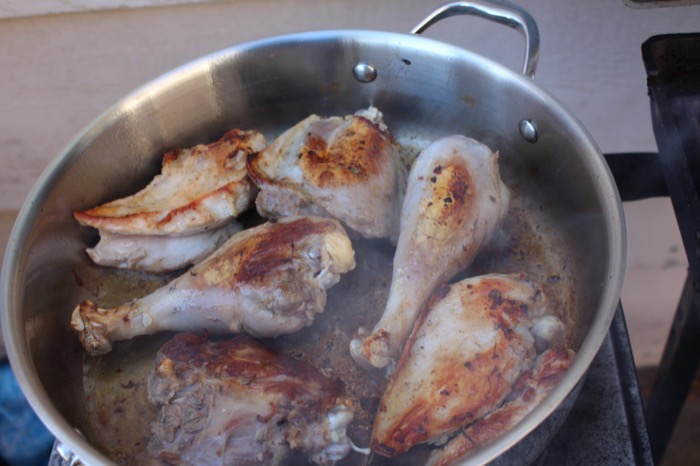
Next I added about 1/4 cup of cognac. I was supposed to light the cognac on fire to burn off the alcohol, but it wouldn’t light, and after a few tries I gave up. Is the flaming thing just a gimmick? If the Coq was going to cook for a couple of hours I imagined the alcohol would be long gone by then.
The cognac helped to deglaze the pan, and gave the sauce a really deep sweet aroma. I added a whole bottle of red wine (the recipe called for 3 cups, but that was already most of the bottle, so what the hell), some chicken stock, and a handful of aromatics (tomato paste, bay leaves, thyme, crushed garlic, salt and pepper).
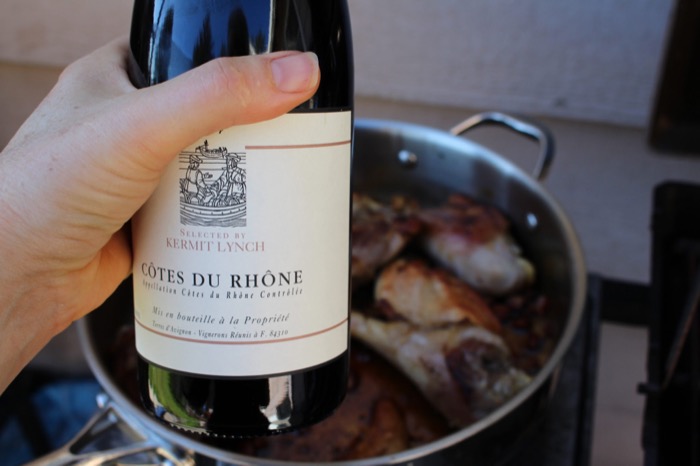
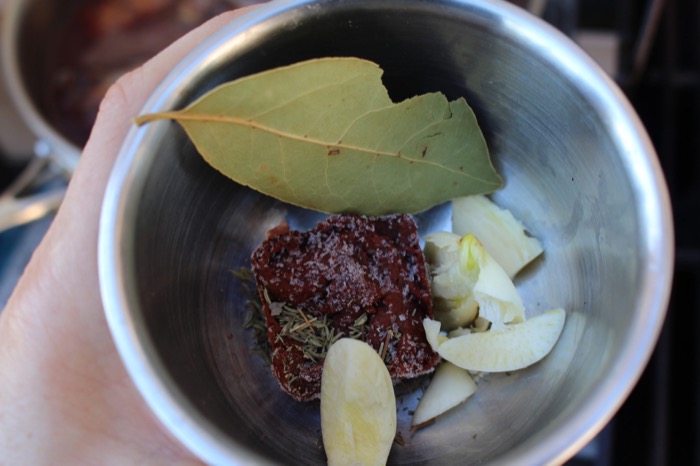
And then it was time to cook the coq for a couple hours at a very, very low simmer.
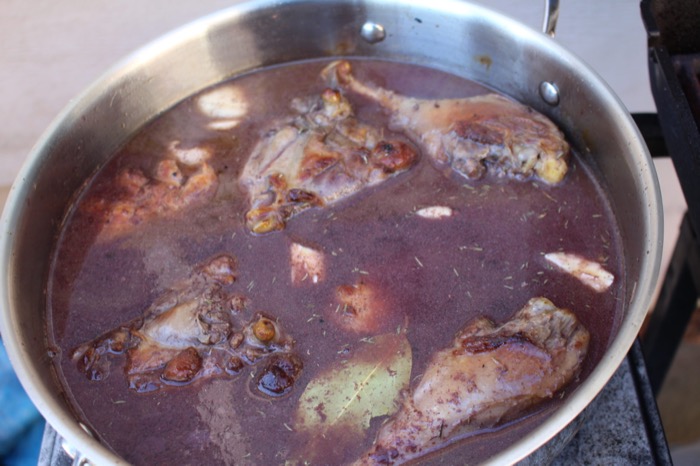
Bubble, Bubble
I was cooking my coq outside on a burner on my gas grill (long story: vegetarian husband, poor kitchen ventilation). It was difficult to get a truly low simmer on the grill. At best I could get it to a low boil. Both the sauce and the chicken cooked probably faster than they should have, but I checked up on it once a half hour or so, turned the chicken and added water if the sauce had reduced too much.
An hour later the chicken was clearly not done — it was cooked but still tough. After 2 hours, the chicken was soft but not completely as soft as I wanted it to be. After 2 1/2 hours we were nearly there, so I added onions and mushrooms.
Julia’s recipe for coq au vin has an additional side-dish recipe for browned pearl onions and mushrooms. When I started this process I was already somewhat dubious about this part, because the idea of peeling a zillion pearl onions sounded like even less fun than tending a pot at a simmer for three hours. It turns out that you can buy frozen pre-peeled pearl onions by the bag. Score!
When it came down to the time to actually make the onion and mushroom side dish, however, I spontaneously decided that rather than cooking the vegetables separately it would be enough to just toss the onions and mushrooms into the sauce and cook them along with the chicken. That shortcut probably disqualifies this as a truly authentic coq au vin, but at that point in the process I was less interested in 100% true authenticity than I was being done, and eating. So, vegetables into the pot for 20 minutes.
The Final Result
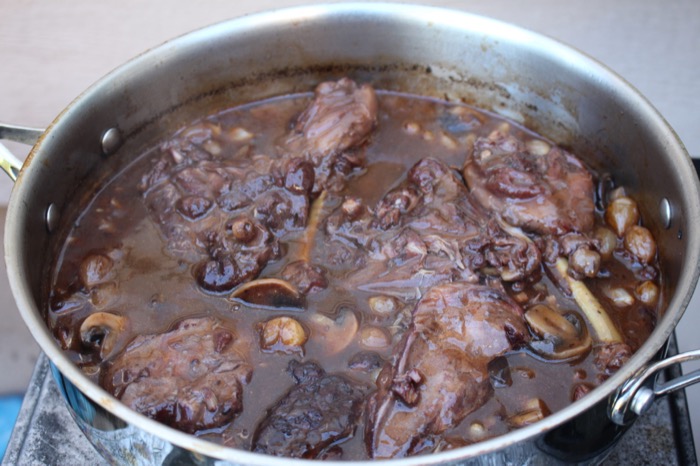
Yum.
The chicken: Tender and extremely flavorful. Not as tender as a modern meat chicken, and cooking it longer would not have made it more tender. Older chicken is just different. Still tasty.
The sauce: thick and intensely wine-flavored, with an underlying fruity sweetness. The pork had dissolved into the sauce during the long cooking time, adding a dense richness.
The vegetables: Perhaps not as tasty as if they had been browned alone, but still earthy and rich.
I ate a nice big bowl of it when it was hot and the rest over the next few days. It keeps and reheats well in the microwave.
Recipe: Laura’s Traditional Coq Au Vin with Real Coq
Based on Coq Au Vin from Mastering the Art of French Cooking (Julia Child, Simone Beck, Louisette Bertholle)
Ingredients
3-4 oz lardons, bacon, or pancetta
2T butter
2 1/2 – 3 lbs cut up older rooster, or stewing hens
1/2 t salt
1/8 t pepper
1/4 C cognac (optional)
1 750ml bottle young, full-bodied red wine (Burgundy, Beaujolais, Cotes du Rhone, Chianti) (don’t spend a lot of money, but don’t cheap out either. $10-15 is fine)
1-2 C good quality chicken stock or beef bullion.
1/2 T tomato paste
2 cloves garlic, mashed
1/4 t thyme
1 bay leaf
1 package frozen peeled pearl onions
1/2 lb mushrooms
1 T flour
2T softened butter
Fresh parsley
Directions
-
Cut up the lardons/bacon/pancetta into small cubes and sauce in the butter in a large heavy casserole until lightly browned. Remove from the pan.
-
Dry the chicken pieces and brown on all sides in the leftover fat. Season with salt and pepper
-
Add the pork back to the pan. Cover and cook on low heat for 15 minutes. Pour in the cognac, and ignite it with a lit match. Shake the pan a little until the flame subside (if it won’t light, don’t worry about it.)
-
Add the entire bottle of wine and enough stock to cover the chicken. Stir in the tomato paste, garlic, and herbs. Stir well and bring to a low simmer.
-
Simmer slowly until the chicken is nearly done but not falling off the bone. This can take 20-30 minutes for a modern chicken or many hours for an old stewing hen. Add more stock if the level of the sauce drops too far.
-
While the chicken is cooking, blend the butter and the flour into a small bowl.
-
Remove the chicken from the pan. Add the butter and flour to the pan, turn the heat up to medium, and stir hard to thicken the sauce.
-
Add the chicken back into the pan, along with the mushrooms and the pearl onions (which can remain frozen). Raise the heat and simmer another 20 minutes until the mushrooms and onions are cooked through.
-
Serve with a dusting of chopped parsley.